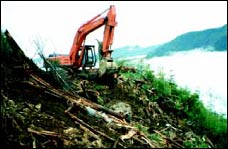| Forest Road Deactivation Practices | |
| in the Pacific Northwest | |
| 4 - Safety and Road Surface | Working In Isolation, Insloping/Outsloping |
As deactivation activities are frequently carried out by people working alone in isolated areas, sound safety practices are extremely important. A reliable physical or radio check-in procedure must be set up and followed at all times.  Radio check-ins should occur at least three times daily, preferably more often. Unreliable radio equipment will lead to misunderstandings and an inconsistent approach to safety check-ins. In areas out of radio contact, set up a physical check-in procedure. Some jurisdictions and companies have established rules for check-ins.
Radio check-ins should occur at least three times daily, preferably more often. Unreliable radio equipment will lead to misunderstandings and an inconsistent approach to safety check-ins. In areas out of radio contact, set up a physical check-in procedure. Some jurisdictions and companies have established rules for check-ins.
Operators should always be aware if there are others working close by, specifically downslope from the work site. Be aware of possible "rain-on-snow events" on slopes above you, as this is a time when landslides and snow avalanches occur. Follow legal shutdown rules (rainfall limits), and always consider voluntary shutdown guidelines especially when working in steep or potentially unstable terrain.
When working in isolation, only experienced operators should carry out risky operations such as benching down to retrieve extra fill. Do not work under high, unstable cutslope faces. Operators must recognize indicators of unstable road fills, tension cracks, displaced road sections, and unstable cutslopes. Discuss safety concerns with supervisors, and call someone with more experience or expertise if necessary. Never proceed if a safe approach or escape route is not obvious.
Where access is maintained, users of deactivated roads should be made aware of potential safety concerns. Deep cross-ditches, outsloped roads in snow and ice areas, and removed bridges are examples of potential hazards. It some cases, it may be appropriate or even mandatory (in BC) to post warning signs.
Insloping is the re-shaping of road surfaces to direct water towards roadcuts and away from potentially unstable or erodible material. Outsloping is the re-shaping of road surfaces to disperse water off road surfaces and onto fillslopes. Fillslopes must be stable and erosion-resistant. For both practices, the ditch is not necessarily required.
Scarification (also referred to as silvicultural fluffing) is the breaking up of road surfaces in an effort to promote and establish vegetation. Road surfaces should be broken up to below the ballast depth in order to expose some plantable spots.
Decompaction is the breaking up of road fill material (ballast and subgrade), and is used primarily to encourage lateral water movement under retrieved road fills. Decompaction must extend to a depth below the bottom of the ditch, and the subsurface outsloped to encourage flow-thru water management. If the ditchline is not intercepted, then decompaction will not be effective.
| 4 - Safety and Road Surface |
| Next |
||
|
Safety and Road Surface 4
|
|
|
©1999 - 2002 Flip Productions Limited Used with permission by CulvertBC |